Lexus IS220d 2012 Owner's Manual
Manufacturer: LEXUS, Model Year: 2012, Model line: IS220d, Model: Lexus IS220d 2012Pages: 609, PDF Size: 14.63 MB
Page 161 of 609

152
2-1. Driving procedures
IS250/220d/200d_EE
Page 162 of 609
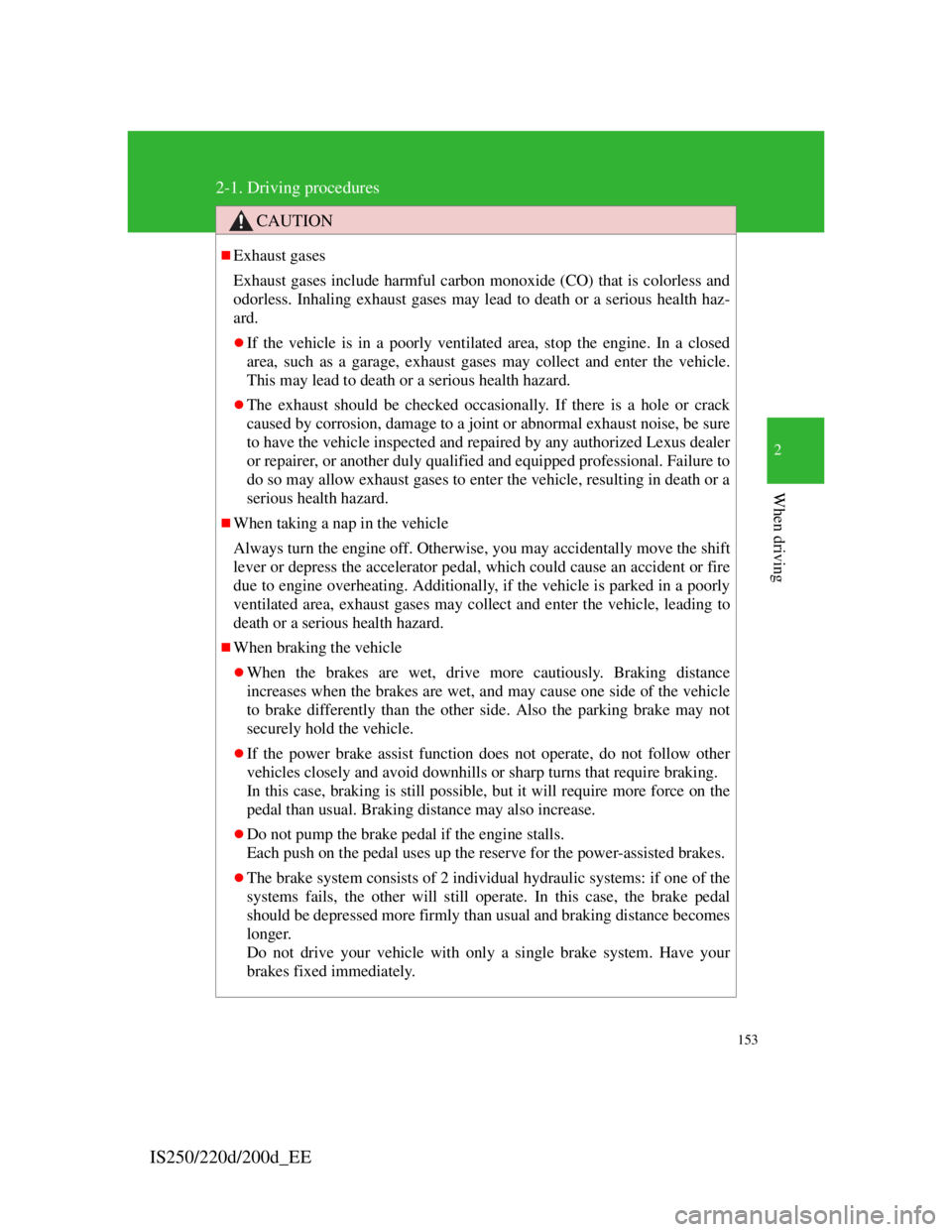
153
2-1. Driving procedures
2
When driving
IS250/220d/200d_EE
CAUTION
Exhaust gases
Exhaust gases include harmful carbon monoxide (CO) that is colorless and
odorless. Inhaling exhaust gases may lead to death or a serious health haz-
ard.
If the vehicle is in a poorly ventilated area, stop the engine. In a closed
area, such as a garage, exhaust gases may collect and enter the vehicle.
This may lead to death or a serious health hazard.
The exhaust should be checked occasionally. If there is a hole or crack
caused by corrosion, damage to a joint or abnormal exhaust noise, be sure
to have the vehicle inspected and repaired by any authorized Lexus dealer
or repairer, or another duly qualified and equipped professional. Failure to
do so may allow exhaust gases to enter the vehicle, resulting in death or a
serious health hazard.
When taking a nap in the vehicle
Always turn the engine off. Otherwise, you may accidentally move the shift
lever or depress the accelerator pedal, which could cause an accident or fire
due to engine overheating. Additionally, if the vehicle is parked in a poorly
ventilated area, exhaust gases may collect and enter the vehicle, leading to
death or a serious health hazard.
When braking the vehicle
When the brakes are wet, drive more cautiously. Braking distance
increases when the brakes are wet, and may cause one side of the vehicle
to brake differently than the other side. Also the parking brake may not
securely hold the vehicle.
If the power brake assist function does not operate, do not follow other
vehicles closely and avoid downhills or sharp turns that require braking.
In this case, braking is still possible, but it will require more force on the
pedal than usual. Braking distance may also increase.
Do not pump the brake pedal if the engine stalls.
Each push on the pedal uses up the reserve for the power-assisted brakes.
The brake system consists of 2 individual hydraulic systems: if one of the
systems fails, the other will still operate. In this case, the brake pedal
should be depressed more firmly than usual and braking distance becomes
longer.
Do not drive your vehicle with only a single brake system. Have your
brakes fixed immediately.
Page 163 of 609

154
2-1. Driving procedures
IS250/220d/200d_EE
NOTICE
When driving the vehicle
Do not depress the accelerator and brake pedals at the same time during
driving. If the brake pedal is depressed while driving with the accelerator
pedal depressed, driving torque may be restrained.
With automatic transmission vehicles
Do not use the accelerator pedal or depress the accelerator and brake ped-
als together to hold the vehicle on a hill.
With manual transmission vehicles
Do not rest your foot on the clutch pedal while driving.
Doing so may cause clutch trouble.
Do not use any gears other than the first gear when starting off and mov-
ing forward.
Doing so may damage the clutch.
Do not use the clutch to hold the vehicle when stopping on an uphill
grade.
Doing so may damage the clutch.
When parking the vehicle
With automatic transmission vehicles, always put the shift lever in P. Failure
to do so may cause the vehicle to move or the vehicle may accelerate sud-
denly if the accelerator pedal is accidentally depressed.
Avoiding damage to vehicle parts
Do not turn the steering wheel fully in either direction and hold it there for
a long time.
Doing so may damage the power steering motor.
When driving over bumps in the road, drive as slowly as possible to avoid
damaging the wheels, underside of the vehicle, etc.
IS220d and IS200d: Make sure to idle the engine immediately after high-
speed driving or hill climbing. Stop the engine only after the turbocharger
has cooled down.
Failure to do so may cause damage to the turbocharger.
Page 164 of 609
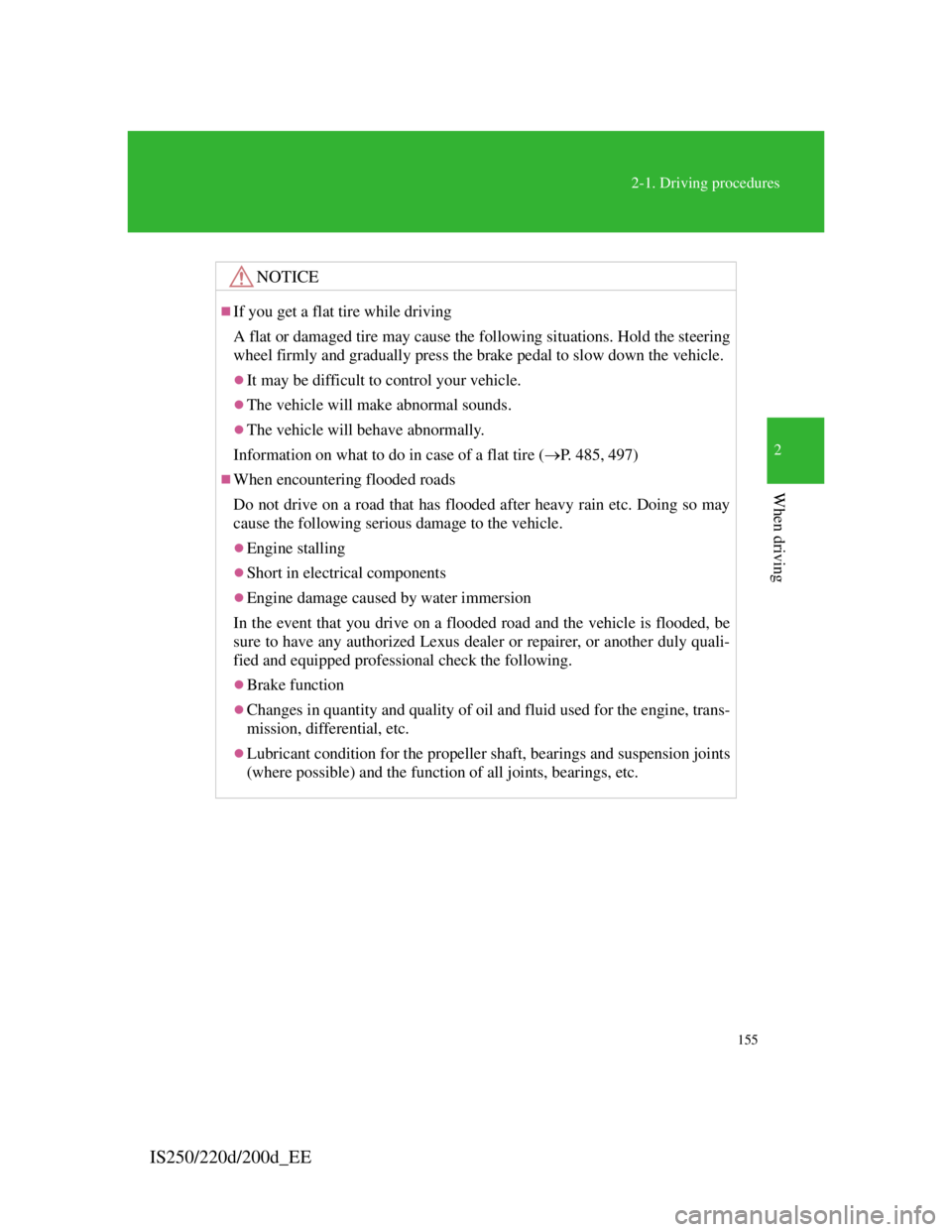
155
2-1. Driving procedures
2
When driving
IS250/220d/200d_EE
NOTICE
If you get a flat tire while driving
A flat or damaged tire may cause the following situations. Hold the steering
wheel firmly and gradually press the brake pedal to slow down the vehicle.
It may be difficult to control your vehicle.
The vehicle will make abnormal sounds.
The vehicle will behave abnormally.
Information on what to do in case of a flat tire (P. 485, 497)
When encountering flooded roads
Do not drive on a road that has flooded after heavy rain etc. Doing so may
cause the following serious damage to the vehicle.
Engine stalling
Short in electrical components
Engine damage caused by water immersion
In the event that you drive on a flooded road and the vehicle is flooded, be
sure to have any authorized Lexus dealer or repairer, or another duly quali-
fied and equipped professional check the following.
Brake function
Changes in quantity and quality of oil and fluid used for the engine, trans-
mission, differential, etc.
Lubricant condition for the propeller shaft, bearings and suspension joints
(where possible) and the function of all joints, bearings, etc.
Page 165 of 609
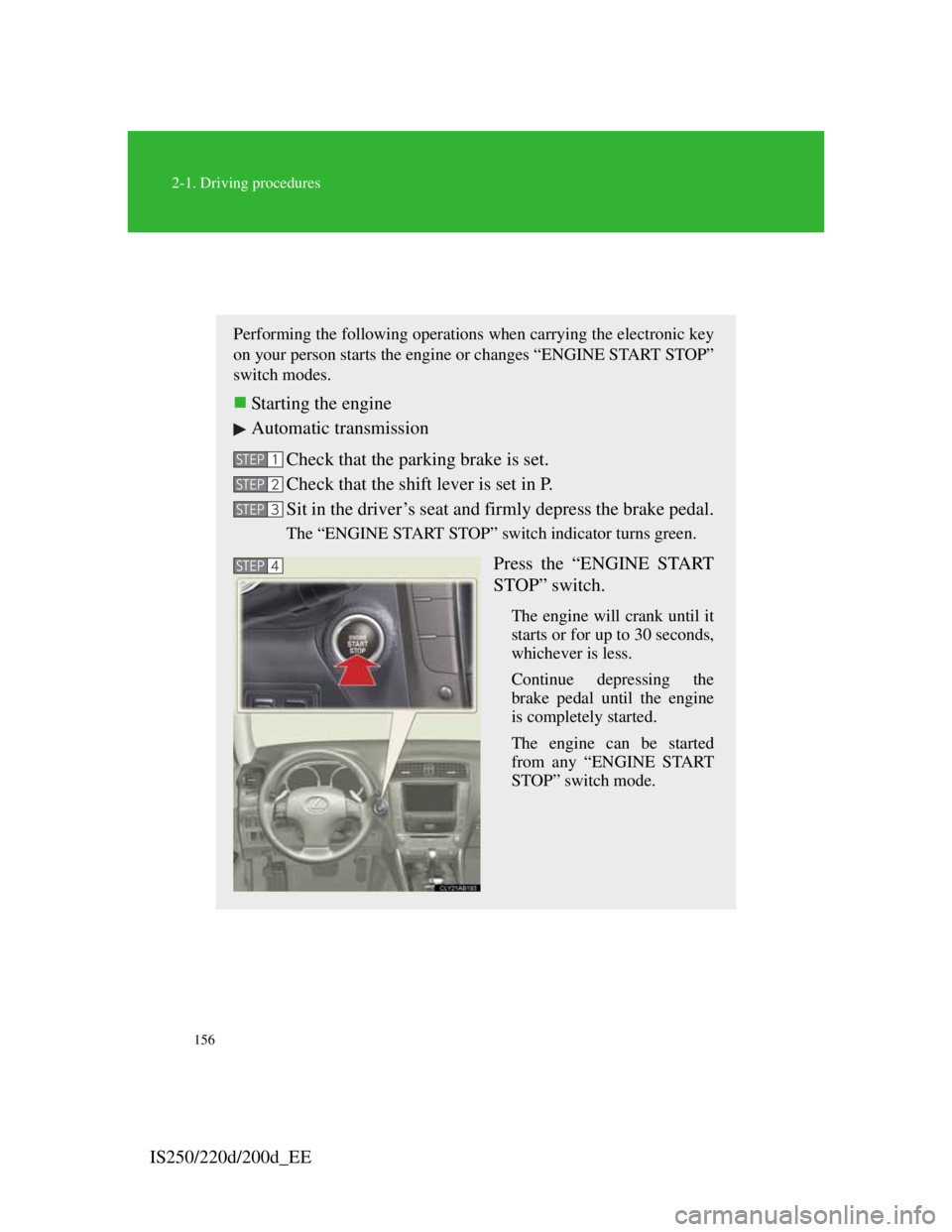
156
2-1. Driving procedures
IS250/220d/200d_EE
Engine (ignition) switch
Performing the following operations when carrying the electronic key
on your person starts the engine or changes “ENGINE START STOP”
switch modes.
Starting the engine
Automatic transmission
Check that the parking brake is set.
Check that the shift lever is set in P.
Sit in the driver’s seat and firmly depress the brake pedal.
The “ENGINE START STOP” switch indicator turns green.
Press the “ENGINE START
STOP” switch.
The engine will crank until it
starts or for up to 30 seconds,
whichever is less.
Continue depressing the
brake pedal until the engine
is completely started.
The engine can be started
from any “ENGINE START
STOP” switch mode.
STEP1
STEP2
STEP3
STEP4
Page 166 of 609
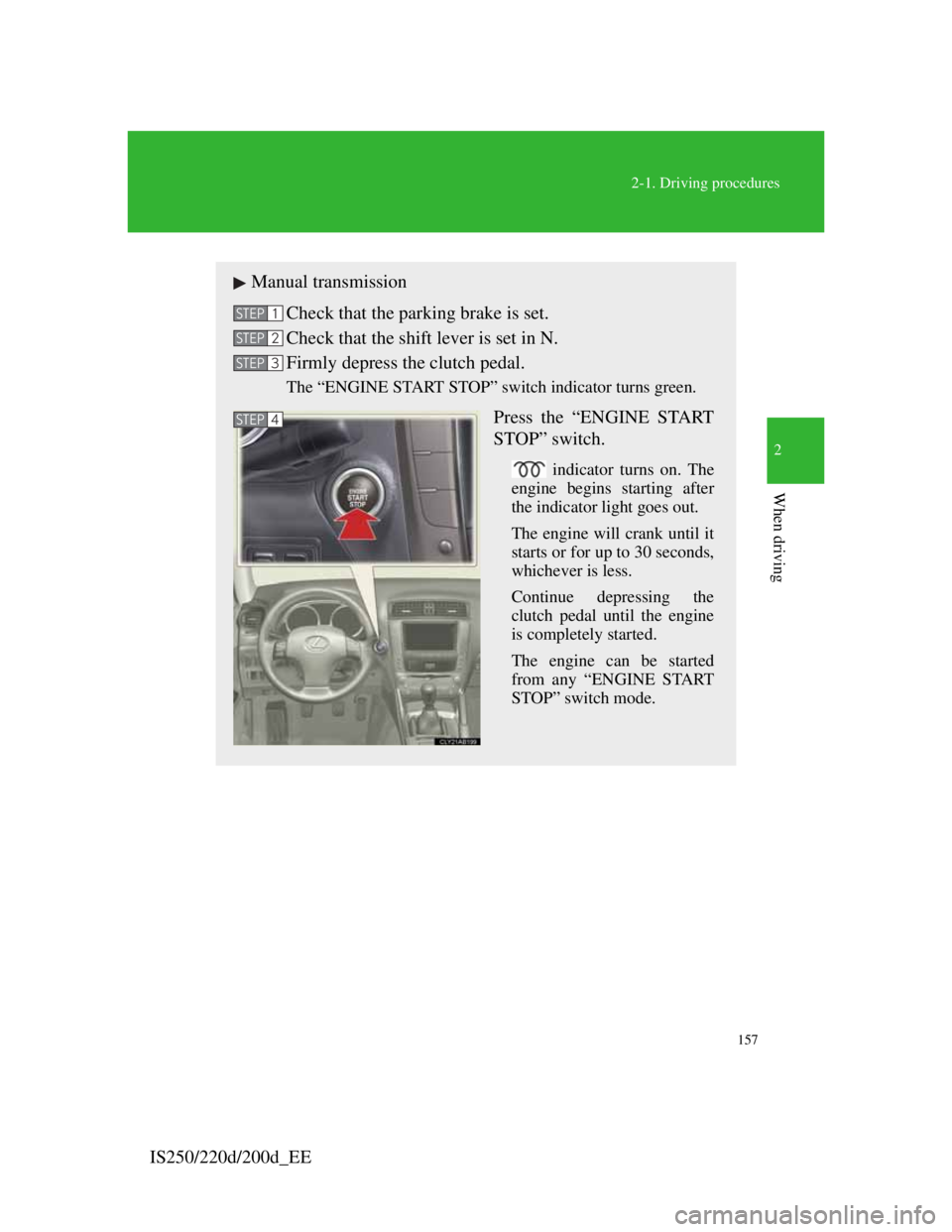
157
2-1. Driving procedures
2
When driving
IS250/220d/200d_EE
Manual transmission
Check that the parking brake is set.
Check that the shift lever is set in N.
Firmly depress the clutch pedal.
The “ENGINE START STOP” switch indicator turns green.
Press the “ENGINE START
STOP” switch.
indicator turns on. The
engine begins starting after
the indicator light goes out.
The engine will crank until it
starts or for up to 30 seconds,
whichever is less.
Continue depressing the
clutch pedal until the engine
is completely started.
The engine can be started
from any “ENGINE START
STOP” switch mode.
STEP1
STEP2
STEP3
STEP4
Page 167 of 609
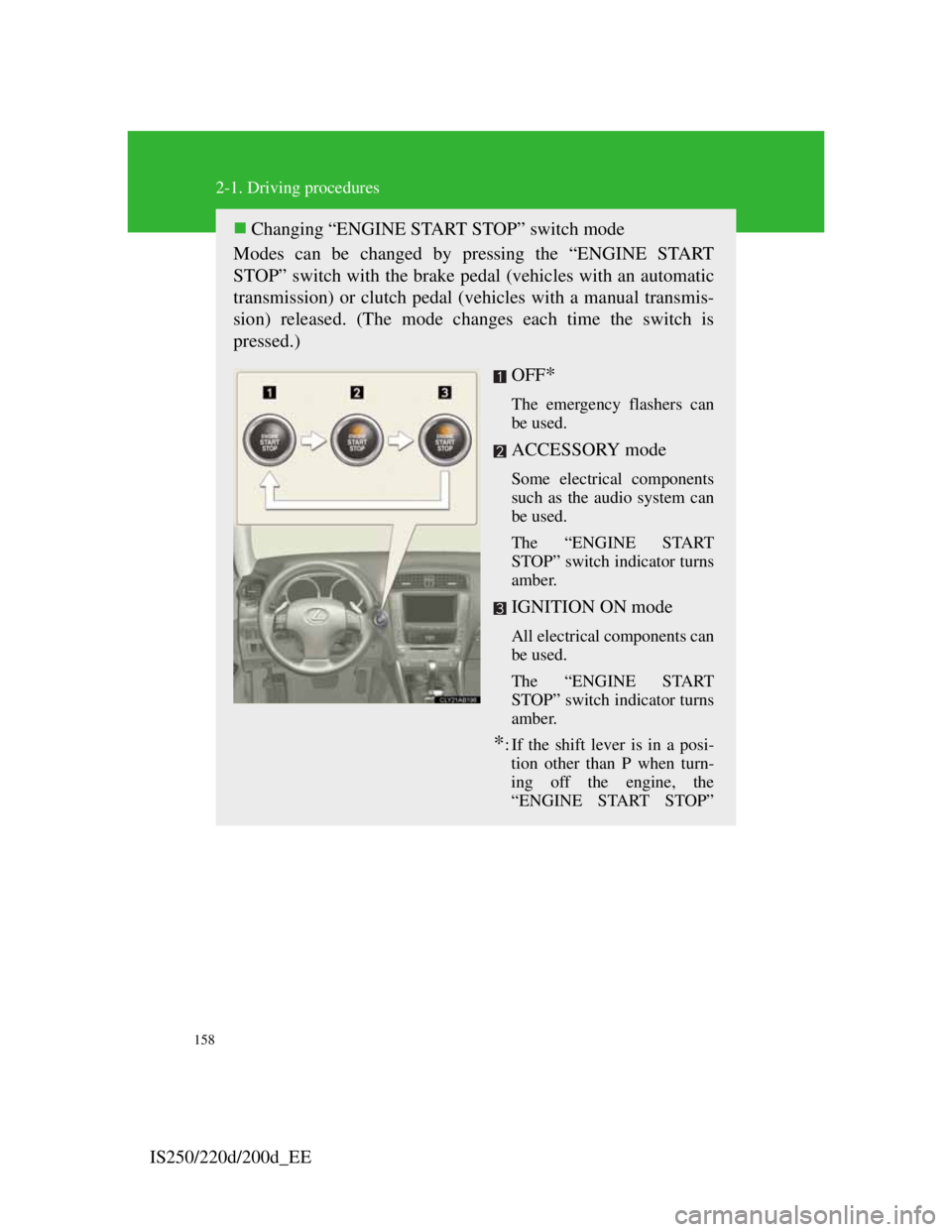
158
2-1. Driving procedures
IS250/220d/200d_EE
Changing “ENGINE START STOP” switch mode
Modes can be changed by pressing the “ENGINE START
STOP” switch with the brake pedal (vehicles with an automatic
transmission) or clutch pedal (vehicles with a manual transmis-
sion) released. (The mode changes each time the switch is
pressed.)
OFF
*
The emergency flashers can
be used.
ACCESSORY mode
Some electrical components
such as the audio system can
be used.
The “ENGINE START
STOP” switch indicator turns
amber.
IGNITION ON mode
All electrical components can
be used.
The “ENGINE START
STOP” switch indicator turns
amber.
*: If the shift lever is in a posi-
tion other than P when turn-
ing off the engine, the
“ENGINE START STOP”
Page 168 of 609
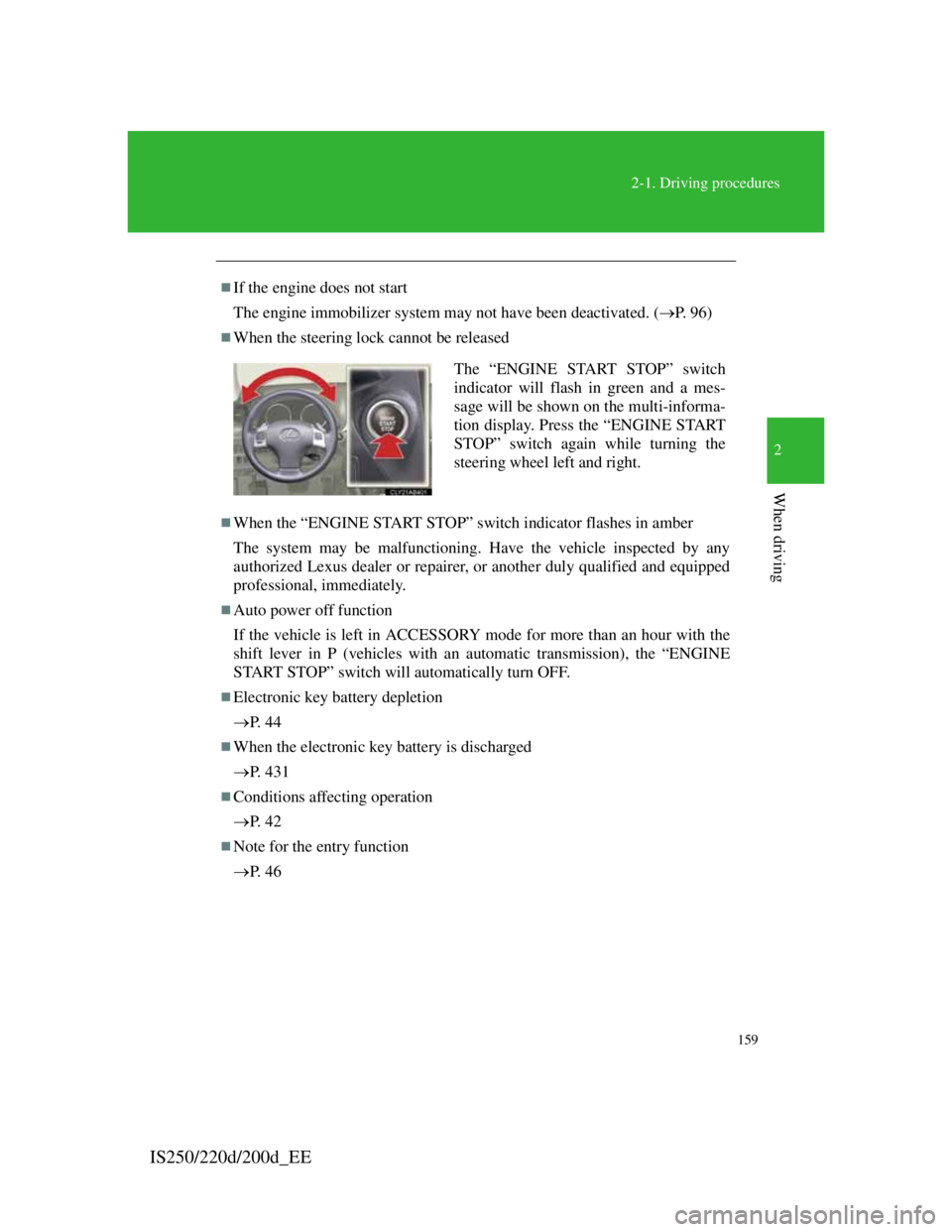
159
2-1. Driving procedures
2
When driving
IS250/220d/200d_EE
If the engine does not start
The engine immobilizer system may not have been deactivated. (P. 9 6 )
When the steering lock cannot be released
When the “ENGINE START STOP” switch indicator flashes in amber
The system may be malfunctioning. Have the vehicle inspected by any
authorized Lexus dealer or repairer, or another duly qualified and equipped
professional, immediately.
Auto power off function
If the vehicle is left in ACCESSORY mode for more than an hour with the
shift lever in P (vehicles with an automatic transmission), the “ENGINE
START STOP” switch will automatically turn OFF.
Electronic key battery depletion
P. 4 4
When the electronic key battery is discharged
P. 4 3 1
Conditions affecting operation
P. 4 2
Note for the entry function
P. 4 6
The “ENGINE START STOP” switch
indicator will flash in green and a mes-
sage will be shown on the multi-informa-
tion display. Press the “ENGINE START
STOP” switch again while turning the
steering wheel left and right.
Page 169 of 609
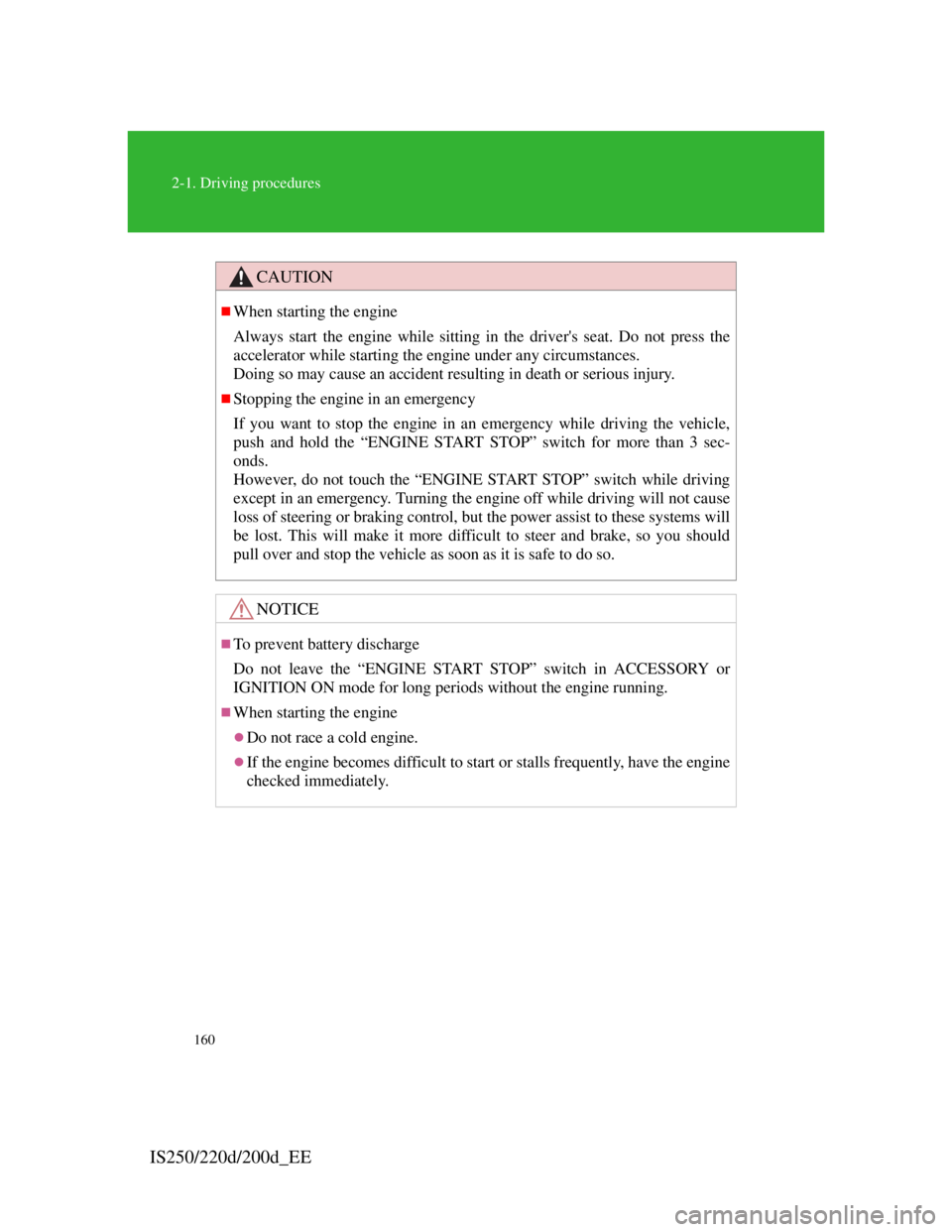
160
2-1. Driving procedures
IS250/220d/200d_EE
CAUTION
When starting the engine
Always start the engine while sitting in the driver's seat. Do not press the
accelerator while starting the engine under any circumstances.
Doing so may cause an accident resulting in death or serious injury.
Stopping the engine in an emergency
If you want to stop the engine in an emergency while driving the vehicle,
push and hold the “ENGINE START STOP” switch for more than 3 sec-
onds.
However, do not touch the “ENGINE START STOP” switch while driving
except in an emergency. Turning the engine off while driving will not cause
loss of steering or braking control, but the power assist to these systems will
be lost. This will make it more difficult to steer and brake, so you should
pull over and stop the vehicle as soon as it is safe to do so.
NOTICE
To prevent battery discharge
Do not leave the “ENGINE START STOP” switch in ACCESSORY or
IGNITION ON mode for long periods without the engine running.
When starting the engine
Do not race a cold engine.
If the engine becomes difficult to start or stalls frequently, have the engine
checked immediately.
Page 170 of 609
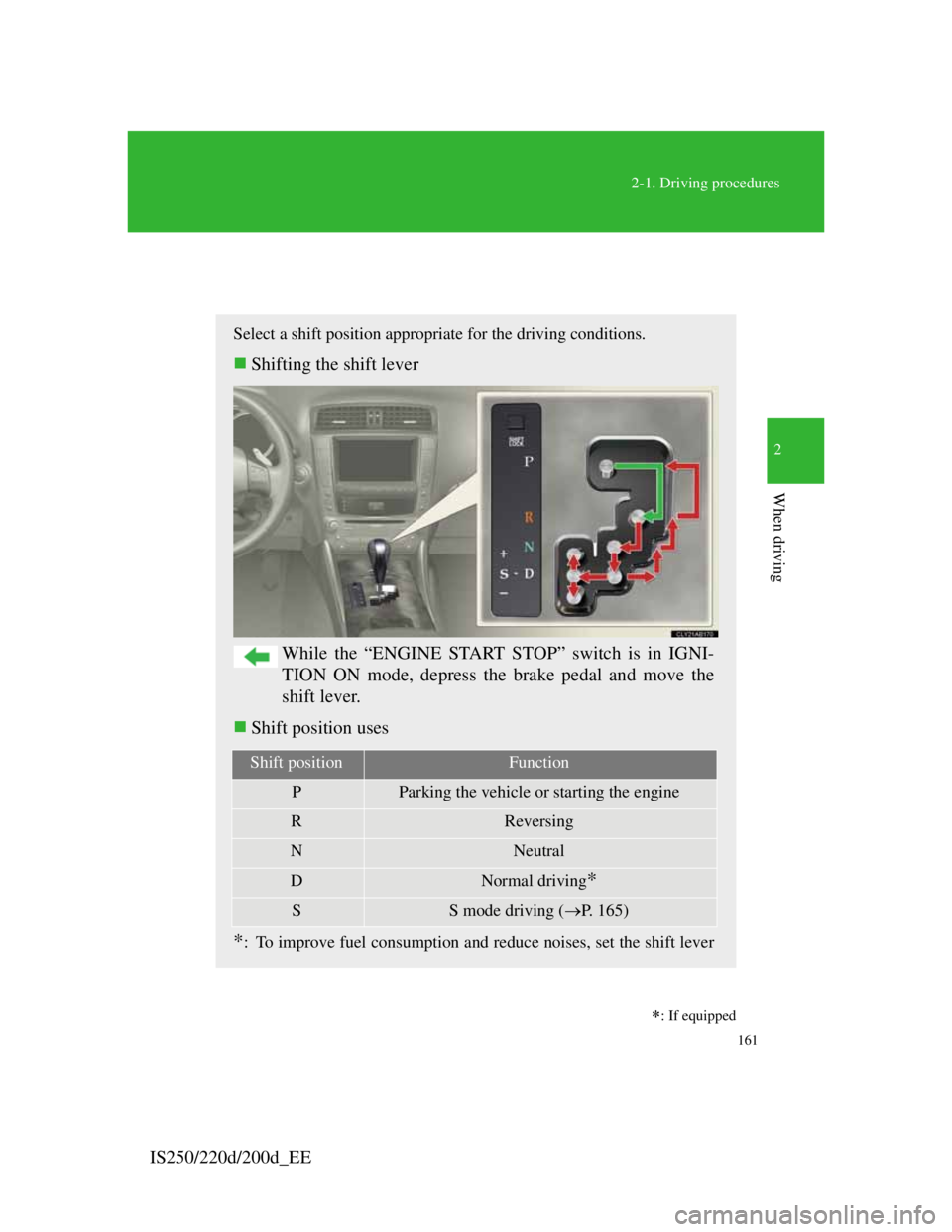
161
2-1. Driving procedures
2
When driving
IS250/220d/200d_EE
Automatic transmission
Select a shift position appropriate for the driving conditions.
Shifting the shift lever
While the “ENGINE START STOP” switch is in IGNI-
TION ON mode, depress the brake pedal and move the
shift lever.
Shift position uses
*: To improve fuel consumption and reduce noises, set the shift lever
Shift positionFunction
PParking the vehicle or starting the engine
RReversing
NNeutral
DNormal driving*
SS mode driving (P. 165)
�
: If equipped